Kaoly Asano (Taiko)
Português | 日本語 | Español

In this fifth concert of the Music in the Castle (Música no Castelo) project, organized by the Japan Foundation, we will have the taiko teacher Kaoly Asano, leader of the group GOCOO – Tokyo Tribal Groove Orchestra, interpreting solo repertoires of the Japanese percussion instrument, the taiko.
The taiko
Percussion is considered one of the oldest instruments of humanity and is present in several cultural traditions of different countries. In Japan, this couldn’t be different. We can start our journey into the taiko world with an incredible narrative taken from the book of chronicles in Japan called Nihon Shoki or Nihongi, which is the second oldest Japanese book we have knowledge of.
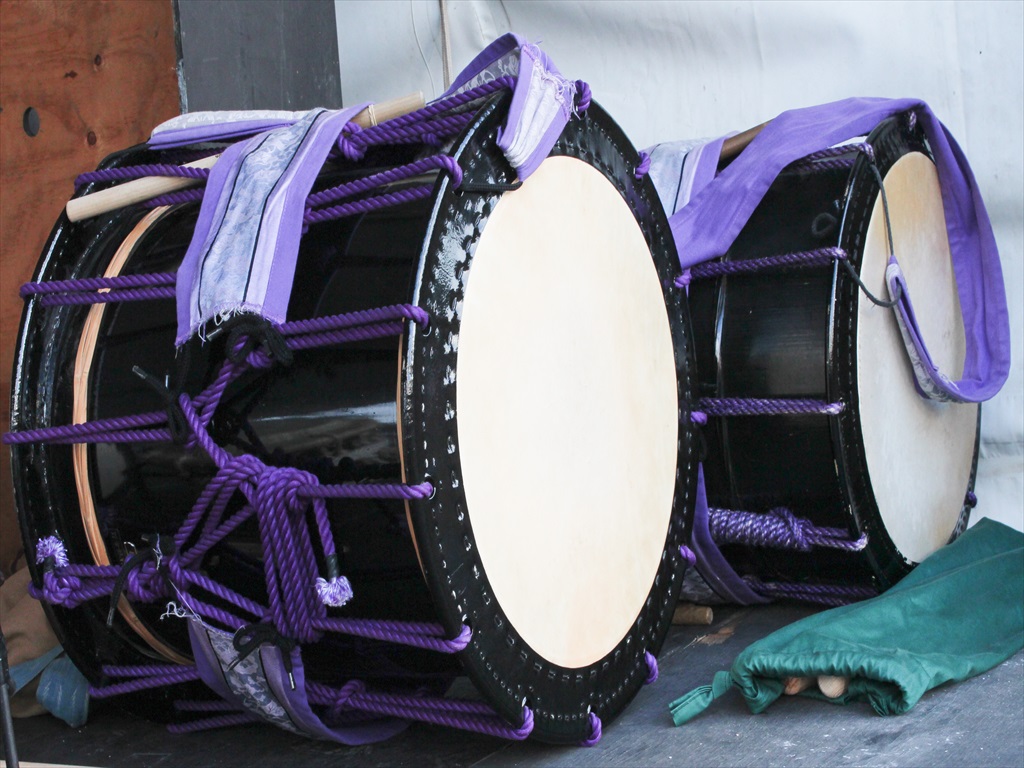
Legend has it that Susanoo, the god of the sea and storms, suddenly became angry and turned all his anger to Earth. His sister, Amaretasu, goddess of the Sun and the universe, was so enraged with the situation that she decided to run away to a cave, closing it with stones and refusing to leave. The other gods then met and knew that without the sun, life on Earth would deteriorate and end. So they tried in so many ways to bring Amaterasu out, begging, threatening, and even trying to physically move the stones, to no avail.
Finally, Ame-no-Uzume-no-mikoto, goddess of dawn and revelry, depicted as an old lady, stepped forward and affirmed that she could bring Amaterasu out of the cave. In spite of being ridiculed by the other gods due to her aged appearance, she went ahead with her plan. Ame-no-Uzume-no-mikoto emptied a barrel of sake and jumped on it, stepping on it furiously to create percussive rhythms. The gods were so moved by that music that all they could was dance and sing. The celebration became so noisy that Amaterasu peeked out of the cave and, seeing the happy scene, brought the light back into the world, banishing Susanoo. Thus, taiko’s music would have emerged from Ame-no-Uzume-no-mikoto’s performance.
In the Japanese language, taiko means a large drum. But it is a common drum, since the instrument expresses feelings of joy, anger, grief, and pleasure based on four principles: attitude, technique, form (kata), and energy (ki).

The origin of the taiko in Japan dates back to A.D. 558. Young Japanese men are said to have traveled to Korea to study the kakko, a two-headed drum, with drumheads stretched by ropes, originated in southern China. This study of Chinese instruments may have influenced the emergence of the taiko. Given the strong similarity of taiko drums to Chinese and Korean drums, it is believed that the drums originated from China or Korea around A.D. 300 to 900.
Certain styles of court music, specifically Gigaku, a type of masked performance, and Gagaku, the court orchestra, were also exported to Japan. In both traditions, dancers would be accompanied by instruments that included similar drums. Some people even speculated that the predecessor of the taiko may have existed in India, around A.D. 400 to 600.
Archaeological evidence shows that the taiko was played in Japan during the Kofun period, A.D. 250 to 538. The word Kofun makes reference to a type of tomb dating from that era, possibly for communication or ritual purposes. This evidence was substantiated by the discovery of statues in the Sawa district of the Gunma Province, which shows two figures, each one holding a a two-skin drum with a stick. The statutes show one player striking one of the drumheads with the stick, and the other using his hand to strike the other drumhead. These statues are considered the oldest evidence of the performance in Japan.
Taiko drums were incorporated into Japanese theater for rhythmic needs, traditional atmosphere, and decoration in certain settings, such as in the Kabuki theater or the Noh theater, which today use the taiko as a musical and aesthetic part of their classical works.
The taiko continues to be used in the classical tradition, termed gagaku, usually presented at the Kyoto Imperial Court. In gagaku, a component of the art is a traditional dance, partly guided by the rhythmic ensemble of the taiko. The instrument also played an important role in many local festivals across Japan. Before the emergence of kumi-daiko (a joint performance with the taiko) groups, after World War II, they were generally used to accompany music of religious rituals, such as the Kagura, a form of Shinto dance, as well as the Bon Odori, the dance on All Souls’ Day.
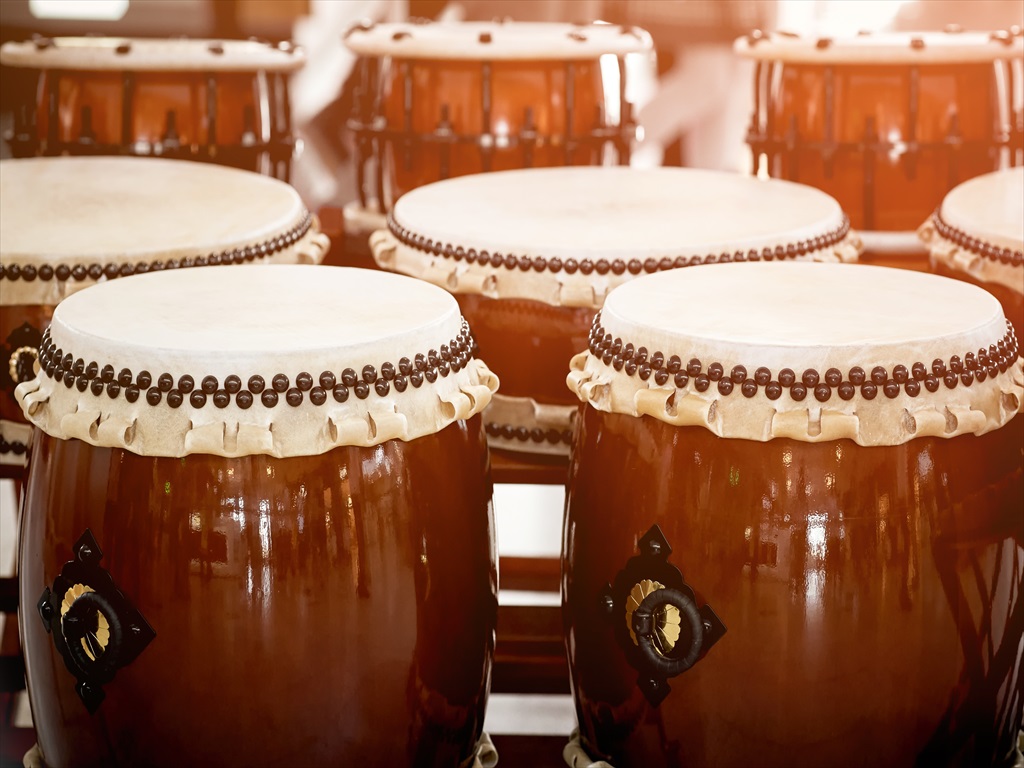
Kumi-daiko groups consist mainly of percussive instruments, in which each drum plays a specific role. Of the different types of taiko, the drum most used in the groups is the nagado-daiko, built by two leather membranes attached by tacks and excavated wood. The chū-daiko, intermediate drums, are common in groups of taiko and was intended to represent the main voice of the group, while the shime-daiko, small drums, of 40 cm in diameter, would define and change the tempo. The larger ō-daiko drums would have an underlying and firm beat, consisting of shime-daiko cross rhythms.
Drums are not the only instruments played in the group. Other Japanese instruments are also included in addition to percussion instruments, the atarigane, a small gong, almost the size of a hand, played with a small drumstick. Of the wind instruments used, bamboo flutes, such as the shakuhachi (vertical) and the shinobue (transversal), sometimes accompany kumi-daiko groups.
Calls or shouts called kakaegoe or kiai are usually used in taiko performances. These are generally used to encourage other players, and may also be used as a signal for transitions or a change in performance dynamics, such as an increase in tempo.
Kaoly Asano, GOCOO – Tokyo Tribal Groove Orchestra (Japan)
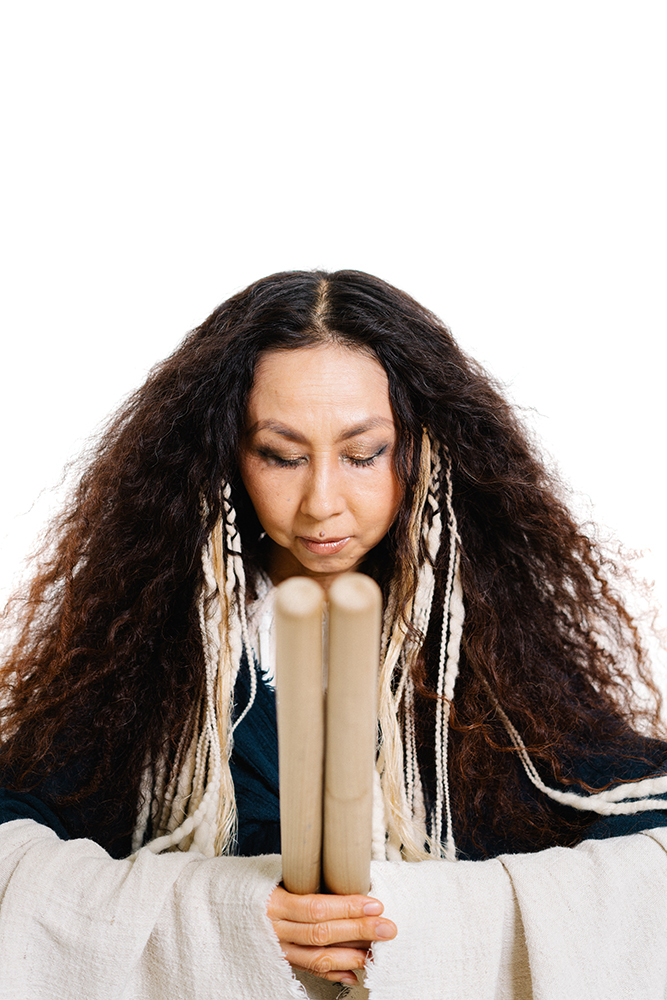
In 1991, Kaoly Asano started as a taiko player and instructor at Baren-Taiko in Asakusa, Tokyo, Japan. In 1997, she formed the group GOCOO – Tokyo Tribal Groove Orchestra, and continues as a leader, songwriter, and performer, forming a new world fusion style of the taiko.
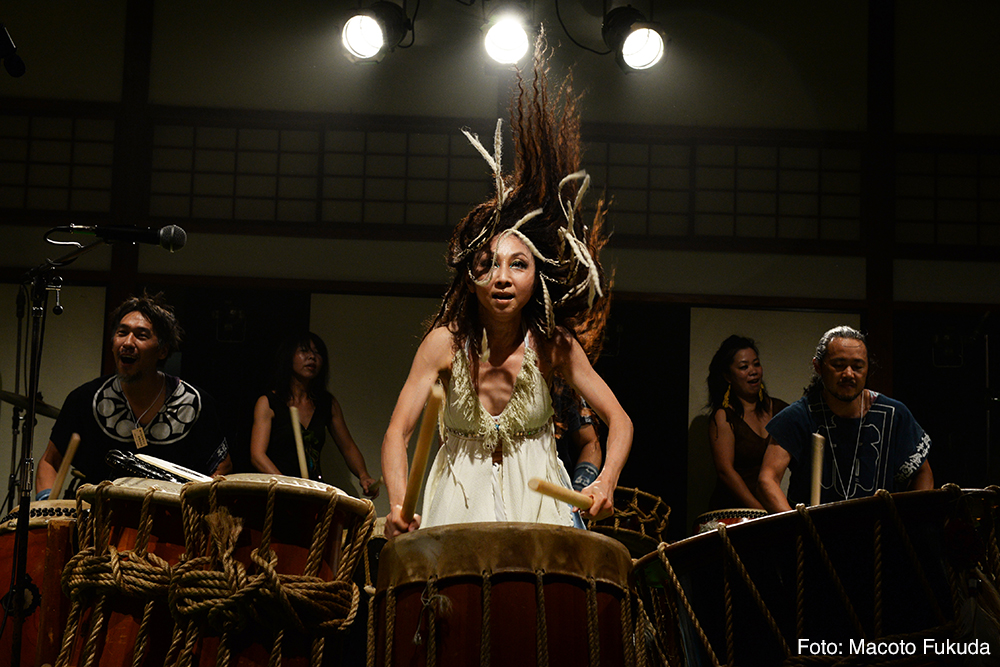
She established the TAWOO Taiko dojo in 1997, teaching, holding workshops and performing at various events, including kindergarten schools and universities. She opened sister dojos in Hokkaido, Yokohama, Chiba, Ise, Nagano, Hamburg, Shanghai, and Brazil, teaching the taiko both in and outside Japan. Every year, since 1997, she has produced a festival, the TAWOO Rhythm, for taiko artists, alongside members of the GOCOO, TAWOO Taiko Dojo, and members of the sister dojos.
With the GOCOO, she toured the United States in 2000, and has been performing every year around the world, mainly in Europe, since 2003. In May 2020, they performed 242 concerts in 40 countries.

Her compositions were used in the soundtrack of the films Matrix Reloaded and Matrix Revolutions. She has also performed in Europe and Latin America, in addition to Australia and other countries, and in shows of various genres and major festivals, including the WOMAD, in the United Kingdom, the SZIGET, in Hungary, the Montreux Jazz Festival, in Switzerland, and the BOOM Festival, in Portugal.
In her solo career, she participated in the Third European Taiko Conference in Hamburg, in 2018, as head of the workshop leader. In the following year, she held a workshop at the kaDON Fall Retreat for the United States taiko community in Wisconsin, also as head of the workshop. In February 2020, she participated as one of the representatives female TAIKO drummers from Japan in the HERbeat show, in Minneapolis, as one of the Japanese representatives of the taiko. She participated in the documentary HERbeat, integrating the cast.
She has also performed in European Capital of Culture events in Austria (2002) and Greece (2006), Cervantino Festival in Mexico, one of the largest festivals in Latin America (2005), Mawazine Festival, sponsored by the Kingdom of Morocco (2008 and 2011), and the COP10 Concert, Live Nature, sponsored by the United Nations in Germany (2008).

“All the songs to be presented in this event were created and played as a GOCOO repertoire. These songs originally consisted of several parts, played by 12 members. Especially for the “Music in the Castle” project, I have made an arrangement to play in solo format. In a solo session it is certainly possible to hear the sound of one person only, but I could feel the sounds of the members of the GOCOO and of all the people with whom I have performed in Japan and in the world. It was a happy and incredible experience. The sound of all people is within me. I feel replenished with the sounds of everyone. If I had created this song to be played in solo format from the beginning, I probably wouldn’t have been able to compose a song like this. At this moment, when we have had to keep our distance from loved ones all of a sudden; at this moment, when people cannot get together, hug or kiss each other; the moment I was suddenly left all by myself, I was able to understand how we were living in an environment of connection with people. I hope this sound can reach everyone’s heart. I deeply pray for the day when we can all get together, laugh, and hug each other for real, and not virtually or online as soon as possible.”
Kaoly Asano
Songs
寿限無 JUGEM
is one of the Rakugo (traditional art of storytelling) plays from Japan, which tells a fun story of parents who, when wishing that their newborn son would have a long and healthy life, end up giving him an absurdly long name, putting several words of good omen, side by side. There are games, the challenge of which is to memorize and repeat the name in the form of word games and tongue twisters. And that’s how this song was created, as a play, in which very long phrases were used, as the JUGEM. “I will be presenting here, not in the form of music, but as beats that represent the long sentences of JUGEM”, reveals Kaoly Asano.
Beat T1
In addition to the artistic activities of the GOCOO, we have a taiko dojo called TAWOO, a place that allows anyone to meet the taiko. The beats in the dojo are simple and appreciated by everyone. It is important for the music to be learned through the body, not the mind. The taiko sound dictates the rhythm the moment the body and mind of the percussionist dance. I hope that everyone can free their bodies and minds through the taiko. The taiko also provides a place where everyone can dance and have fun in a circle, connecting their feelings, since it is the central instrument. This song is an arrangement of TAWOO song version for the GOCOO. Today, played both by dojo students and taiko percussionists in the world, it has become a song loved by all.”
ELEVEN
“This song was composed at the time of the Great East Japan Earthquake, which took place on March 11, 2011 (also known as 3.11). After 3.11, all of Japan was confused, lost, scared, injured, and sad. These were days when everything had stopped. Since I had known the taiko, it was the first time I lived days when I was unable to play the instrument. ELEVEN is a song that was completed in virtually one day, as if it had been conceived by itself and not when the GOCOO members had finally gathered in a circle with their taikos. At that time, although I was still confused and immersed in anxiety and grief, the music conceived was very, very happy, overflowing with hope.
After a long time, after the Rainbow Warriors song, created in 2000 on a GOCOO retreat trip, with Dennis Banks, one of the Native American leaders, had joined the group, the song was completed. Since then, I have been playing this song in Japan and around the world, in many places and with different people. I have been dedicating my life to extending the circle of ELEVEN to the world, through the taiko.
The taiko is a musical instrument with the power to connect the musician’s inner world to the universe, through the percussionist’s body and through sound. Its sound allows one to reach a departed soul. It has the power to bring people together through feelings, showing that the light of hope is concealed within us all the time. Every time I play ELEVEN, we feel suddenly strengthened.
The title ELEVEN was named after the number 11, of the March 11, 2011, date. But now it’s not only about that. Whether anywhere in the world, and more than ever now, even though we are experiencing equally difficult times, we are here, now, because we have overcome difficulties and remain alive, as people have joined forces at all times. For this reason, ELEVEN is also a prayer of hope aimed at people around the world, not just in Japan. May one day we can play ELEVEN together. ”
Ryu-zing
Ryu-zing (dragon god) is the deity that controls water, and its legends exist in several regions of Japan. Unlike western dragons, the dragon god in the east is a god itself. This song is one of my favorites, which I wrote at the beginning of GOCOO’s career and one that I’ve been playing for a long time. The song depicts a human being who plays the taiko to awaken the sleeping dragon god. Upon awakening, it begins to move slowly until it eventually flies freely between heaven and earth.
Ancient River~Mizu no Codoo
“I have combined two songs: Ancient River “Taikono Kawa” and Mizu no Codoo “Mizuno Kodô”. A drop of water is formed in the source of the mountains, gathering in a small murmur, gradually becoming a river, while it flows around the various mountain landscapes, sometimes in a strong way or in a silent way. Finally, it turns into a large river, flowing into the sea and becoming once again a drop in the water source. Mizu no Codoo portrays this magnificent history, and Ancient River reflects on the river that existed in this world, even before the appearance of human beings. The original version refers to the image of a soundtrack to a film. Please listen to the original as well, ” suggests Kaoly Asano.
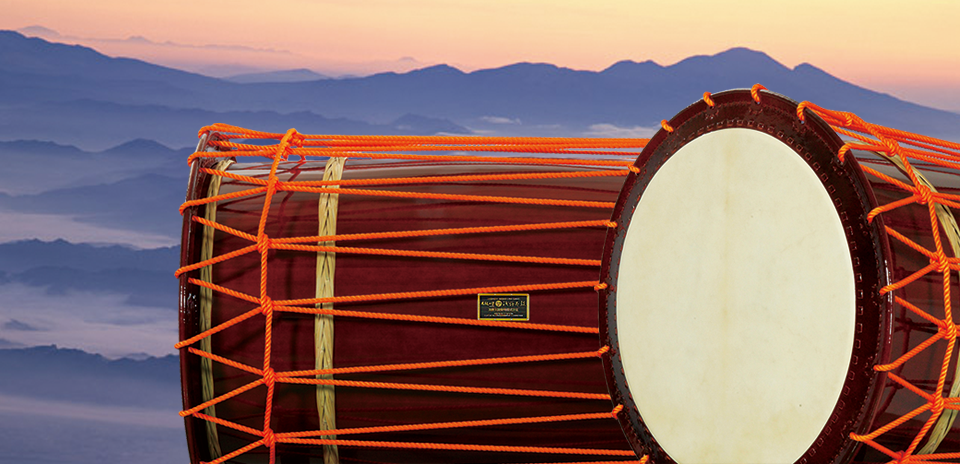
Watch Kaoly Asano’s perf in the Music in the Castle project.



